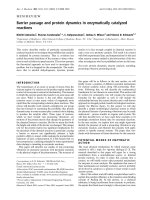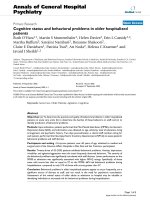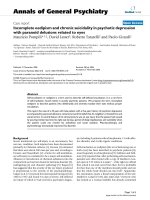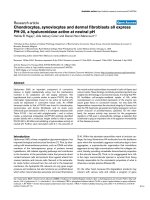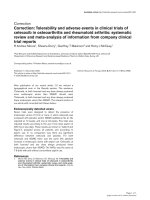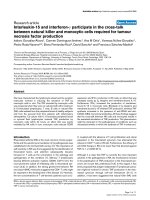Báo cáo y học: "Relative hyperlactatemia and hospital mortality in critically ill patients: a retrospective multi-centre study" pot
Bạn đang xem bản rút gọn của tài liệu. Xem và tải ngay bản đầy đủ của tài liệu tại đây (755.99 KB, 9 trang )
Nichol et al. Critical Care 2010, 14:R25
/>Open Access
RESEARCH
© 2010 Nichol et al.; licensee BioMed Central Ltd. This is an open access article distributed under the terms of the Creative Commons
Attribution License ( which permits unrestricted use, distribution, and reproduction in
any medium, provided the original work is properly cited.
Research
Relative hyperlactatemia and hospital mortality in
critically ill patients: a retrospective multi-centre
study
Alistair D Nichol*
1,3
, Moritoki Egi
2
, Ville Pettila
1
, Rinaldo Bellomo
1,4
, Craig French
5
, Graeme Hart
4
, Andrew Davies
3
,
Edward Stachowski
6
, Michael C Reade
4
, Michael Bailey
1,3
and David James Cooper
1,3
Abstract
Introduction: Higher lactate concentrations within the normal reference range (relative hyperlactatemia) are not
considered clinically significant. We tested the hypothesis that relative hyperlactatemia is independently associated
with an increased risk of hospital death.
Methods: This observational study examined a prospectively obtained intensive care database of 7,155 consecutive
critically ill patients admitted to the Intensive Care Units (ICUs) of four Australian university hospitals. We assessed the
relationship between ICU admission lactate, maximal lactate and time-weighted lactate levels and hospital outcome in
all patients and also in those patients whose lactate concentrations (admission n = 3,964, maximal n = 2,511, and time-
weighted n = 4,584) were under 2 mmol.L
-1
(i.e. relative hyperlactatemia).
Results: We obtained 172,723 lactate measurements. Higher admission and time-weightedlactate concentration
within the reference range was independently associated with increased hospital mortality (admission odds ratio (OR)
2.1, 95% confidence interval (CI) 1.3 to 3.5, P = 0.01; time-weighted OR 3.7, 95% CI 1.9 to 7.00, P < 0.0001). This significant
association was first detectable at lactate concentrations > 0.75 mmol.L
-1
. Furthermore, in patients whose lactate ever
exceeded 2 mmol.L
-1
, higher time-weighted lactate remained strongly associated with higher hospital mortality (OR
4.8, 95% CI 1.8 to 12.4, P < 0.001).
Conclusions: In critically ill patients, relative hyperlactataemia is independently associated with increased hospital
mortality. Blood lactate concentrations > 0.75 mmol.L
-1
can be used by clinicians to identify patients at higher risk of
death. The current reference range for lactate in the critically ill may need to be re-assessed.
Introduction
In healthy individuals there is a continuous cycle of lactate
production and metabolism, which ensures that blood lac-
tate concentrations are normally low [1,2]. Higher blood
lactate concentrations occur when lactate production
exceeds clearance, when clearance capacity is decreased or
more frequently when both occur simultaneously [3,4]. Ele-
vated blood lactate concentrations above the accepted nor-
mal reference range (absolute hyperlactataemia) are
common and associated with increased hospital mortality in
the critically ill [5-12]. Their usefulness in identifying criti-
cally ill patients at higher risk of death has led to the adop-
tion of lactate measurement in most blood gas analyzers
and the frequent measurement of lactate in the critically ill.
While the normal lactate concentration in unstressed indi-
viduals is 1.0 ± 0.5 mmol.L
-1
[1,2], patients with critical ill-
ness are considered to have normal lactate levels at
concentrations of less than 2 mmol.L
-1
[13]. Furthermore,
this 2 mmol.L
-1
cut off may be considered to be a conserva-
tive threshold as some have suggested that a level of up to 4
mmol.L
-1
is within the normal limits [14].
However, it is unknown whether a higher blood lactate
concentration within the current reference range (relative
hyperlactataemia) might also be associated with increased
hospital mortality. This knowledge would be clinically
important because the currently used upper reference limit
* Correspondence:
1
Australian and New Zealand Intensive Care-Research Centre, School of Public
Health and Preventive Medicine, Monash University, Alfred Hospital Campus,
75 Commercial Road, Prahran, VIC 31821, Australia
Nichol et al. Critical Care 2010, 14:R25
/>Page 2 of 9
for lactatemia may fail to identify many patients who are at
higher risk of death.
We hypothesized that higher blood lactate concentrations
within the reference range would be associated with an
increased risk of hospital death and investigated the rela-
tionship between ICU admission, maximal and time-
weighted blood lactate concentrations and hospital mortal-
ity in a large cohort of critically ill patients.
Materials and methods
The data collection and the data analysis for this study are
part of ongoing de-identified data auditing processes across
the participating hospitals, which have all waived the need
for informed consent. The Austin Hospital Ethics Commit-
tee approved the study.
Study population and data sources
We conducted this study as a four-centre retrospective
investigation of a prospectively gathered intensive care
database. Four Australian university teaching hospital
intensive care units enrolled patients in this study. We
included all patients admitted to these ICUs from January
2000 to October 2004.
The blood lactate concentration data used for this study
were stored and retrieved electronically. We obtained age,
sex, use of mechanical ventilation, reason for ICU admis-
sion, surgical and non-surgical divided into (trauma, car-
diac/vascular, gastrointestinal tract, neurological and
thoracic/respiratory diseases), and Acute Physiology and
Chronic Health Evaluation (APACHE) II score [15] from
the electronic data repositories of each ICU, using prospec-
tively collected data as part of a continuing data collection
by the Australian and New Zealand Intensive Care Society -
Centre for Outcome and Resources Evaluation (ANZICS-
CORE). We coded admission diagnosis by APACHE III
system used by the ANZICS-CORE - Adult Patient Data-
base [16].
All patients had initial arterial lactate and blood gas mea-
sured by blood gas analyser (Rapilab, Bayer Australia, Syd-
ney, NSW, Australia, upper normal limit 2.00 mmol.L
-1
) at
the time of admission to the ICU. The timing of repeat mea-
surements was at the discretion of the managing critical
care team. All subsequent blood lactate measurements were
performed using the same blood-gas analyzer in each hospi-
tal. A normal (within reference) lactate was defined as a
concentration between 0.00 and 2.00 mmol.L
-1
[13]. Labo-
ratories in the participating hospitals comply with standards
of the National Association of Testing Authorities [17] and
the Royal College of Pathologists of Australasia [18].
Statistical Analysis
We used the ICU admission (Lac
ADM
) and maximal (Lac-
MAX
) blood lactate concentrations to indicate the admission
and highest value recorded while in the ICU. We first
assessed blood lactate concentration in all patients and sec-
ond, in those patients whose ICU admission (Lac
ADM
), and
maximal (Lac
MAX
) blood lactate concentrations never
exceeded the normal reference range (that is, < 2 mmol.L
-
1
). In addition, to avoid the potential effect of surveillance
bias due to the increased blood lactate monitoring in more
severely ill patients, we calculated the time-weighted lac-
tate concentration (Lac
TW
). This time-weighted method is
more representative of the true lactate level during the ICU
stay than the arithmetic mean, as it assumes a linear trend
between each individual lactate measurement for each
patient during their ICU stay. This method was modified
from, and used in accordance with, an approach previously
used by Finney et al to describe hyperglycaemia [19].
As the relationship between Lac
ADM
, Lac
MAX
, Lac
TW
and
mortality was expected not to be linear in nature, categori-
cal variables were created. We divided lactate into four
bands: normal (0.00 to 2.00 mmol.L
-1
); mild hyperlactemia
(2.01 to 4.00 mmol.L
-1
); moderate hyperlactatemia (4.01 to
6.00 mmol.L
-1
) and severe hyperlactatemia (> 6.01
mmol.L
-1
) for comparison.
The normal range of lactate (0.00 to 2.00 mmol.L
-1
) was
subsequently divided into eight bands. However, due to the
small number of patients with values under < 0.75 mmol.L
-
1
we combined the three lower octiles to achieve adequate
size for statistical comparison. We therefore compared: the
lower limit of normal (LLN, 0.00-0.75 mmol.L
-1
); upper
limit of normal (ULN, 1.76 to 2.00 mmol.L
-1
) and four
intermediate categories (0.75 to 1.00 mmol.L
-1
); (1.01 to
1.25 mmol.L
-1
); (1.26 to 1.50 mmol.L
-1
); (1.51 to 1.75
mmol.L
-1
).
To confirm that any association between Lac
TW
levels
within the normal range and mortality was not being biased
by patients who had individual lactate concentrations above
2 mmol.L
-1
while in the ICU, we then examined the associ-
ation between Lac
TW
and mortality in the cohort of patients
whose lactate never exceeded 2 mmol.L
-1
.
The primary outcome for analysis was hospital mortality
and the secondary outcome was ICU mortality. We per-
formed crude univariate analysis with lactate as a catagorial
variable for comparison between groups according to hos-
pital survival status using chi-square test for proportions,
Student t-test for normally distributed outcomes and Wil-
coxon rank sum tests otherwise. In addition, we performed
multivariate analysis where we adjusted for all available
predictors of hospital mortality included in the models
(gender, age, APACHE II, mechanical ventilation, surgical
admission and diagnosis type) determined by backward
elimination of non-significant variables. Furthermore, to
determine if the lactate associations were consistent across
patient admission diagnosis subgroups and study hospitals,
we examined the interactions between measures of lactate
Nichol et al. Critical Care 2010, 14:R25
/>Page 3 of 9
and other variables in the model. We report results from the
multivariate models using odds ratios, OR (95% confidence
intervals, 95% CI).
All analyses were performed using SAS version 9.2 (SAS
Institute Inc, Cary, NC, USA). A two-sided P-value of 0.05
was considered to be statistically significant.
Results
We studied a heterogeneous cohort of 7,155 critically ill
patients with 172,723 blood lactate measurements (Table
1). The absolute blood lactate concentrations (admission
lactate Lac
ADM
, maximal lactate Lac
MAX
and time-weighted
lactate Lac
TW
), were significantly higher in non-survivors
compared to survivors (Table 1).
Overall assessment of hyperlactatemia (absolute
hyperlactatemia)
A higher crude Lac
ADM
, Lac
MAX
and Lac
TW
concentration
above the reference range (0.00 to 2.00 mmol.L
-1
) was
associated with a higher hospital and ICU mortality rate
(Figure 1, Panel a, b, c, respectively). Multivariate analysis
showed that compared to the current reference lactate con-
centration (0.00 to 2.00 mmol.L
-1
) a higher Lac
ADM
(> 8
mmol.L
-1
), Lac
MAX
(> 10 mmol.L
-1
) and Lac
TW
(> 6
mmol.L
-1
) blood lactate concentration was strongly associ-
ated with an increased adjusted hospital mortality (Lac
ADM
OR213.49 (95% CI 28.69 to 1588.71), P < 0.0001); Lac
MAX
OR8.44 (95% CI 5.99 to 11.91), P < 0.0001) Lac
TW
OR
37.78 (95% CI 18.72 to 76.25), P < 0.0001). This associa-
tion between lactate (Lac
ADM
, Lac
MAX
and Lac
TW
) and
adjusted mortality was independent of admission diagnosis,
admission hospital and APACHE II score.
Assessment of relative hyperlactatemia
We further identified the cohorts of patients with a Lac
ADM
(n = 3,964), Lac
MAX
, (n = 2,511) and with Lac
TW
(n =
4,584) within the current reference range (0.00 to 2.00
mmol.L
-1
). Table 2 shows the clinical characteristics of the
Lac
ADM
subgroup of patients divided into hospital survivors
and non-survivors. Patients with an admission or time
weighted lactate level just below 2 mmol.L
-1
had a crude
hospital mortality rate of approximately 20% (Figures 2a
and 3b). Lac
ADM
, Lac
MAX
and Lac
TW
were significantly
higher in hospital non-survivors compared to survivors
(Table 2).
A higher admission lactate (Lac
ADM
) concentration
within the reference range was associated with higher crude
hospital mortality (Figure 2a), with a mortality rate of
18.5% in the higher risk cohort. There also was a significant
independent relationship between Lac
ADM
within the refer-
ence range and adjusted hospital mortality (Figure 2b).
Higher Lac
TW
within the reference range was independently
associated with higher adjusted hospital mortality (Figure
3b) with a crude mortality rate of 21.1% in the higher risk
cohort (Figure 3a). In addition, higher Lac
TW
(1.5 to 2.00
mmol.L
-1
vs 0.00 to 0.75 mmol.L
-1
) was also independently
associated with hospital mortality in the cohort of patients
whose lactate never exceeded 2 mmol.L
-1
(Lac
TW
OR4.8,
95% CI 1.8 to 12.4, P < 0.001, n = 2,254).
The association between adjusted hospital mortality and
Lac
ADM
and Lac
TW
lactate concentrations within the normal
range was first detected at lactate concentrations over 0.75
mmol.L
-1
and the strength of this association increased with
higher lactate concentrations within the reference range
(Figures 2b and 3b). The detected association between lac-
tate within the reference range and adjusted hospital mortal-
ity was independent of admission diagnosis, admission
hospital and APACHE II score. Interestingly, a higher crude
and adjusted maximal lactate (Lac
MAX
) concentration
within the normal reference range was not independently
associated with increased hospital mortality (data not
shown).
Discussion
Statement of key findings
We tested whether higher levels of lactatemia within the
current reference range (relative hyperlactemia) are inde-
pendently associated with an increased risk of hospital mor-
tality. We found that most patients admitted to ICU had an
admission or time weighted lactate level within the current
normal reference range and yet a crude hospital mortality
rate of approximately 20%. We also found that higher ICU
admission (Lac
ADM
) and time weighted (Lac
TW
) blood lac-
tate concentrations within the normal reference range were
strongly and independently associated with hospital mortal-
ity. In addition, this increased mortality risk was first
detected at lactate concentrations above 0.75 mmol.L
-1
.
Comparison with previous studies
Many studies have found that either Lac
ADM
or Lac
MAX
above the reference range are associated with higher mor-
tality following cardiothoracic surgery [12], trauma [7],
major abdominal surgery [5], high risk surgery, major vas-
cular trauma, sepsis [20], liver disease [21], in ventilated
neonates [22] and critically ill children [11]. Our observa-
tions that the extent of absolute hyperlactatemia is strongly
linked with mortality independent of admission diagnostic
group in a large mixed cohort of critically ill patients con-
firm that lactate is a useful marker in the intensive care set-
ting to identify patients at high risk of death. In addition,
these findings suggest that other observations related to lac-
tate obtained from our cohort might also be generalizable.
In addition, we found that time weighted lactate (Lac
TW
), a
representation of the lactate concentration throughout the
ICU stay, was strongly associated with increasing hospital
Nichol et al. Critical Care 2010, 14:R25
/>Page 4 of 9
mortality. The finding that the duration of this derangement
while in the ICU is associated with increased mortality
expands previous work demonstrating that periods of sus-
tained hyperlactataemia (that is, ongoing excess production
or decreased clearance of lactate) is associated with an
increased risk of death [3,5,23-28].
To our knowledge, this is the first study to assess the rela-
tionship of higher lactate concentrations within the current
reference range and mortality. We found a strong associa-
tion between an increased Lac
ADM
and Lac
TW
within the
current reference range and increased hospital mortality.
Furthermore, we demonstrated that higher Lac
TW
in the
cohort of patients whose lactate ever exceeded 2 mmol.L
-1
was also strongly associated with higher hospital mortality.
These results suggest that relative hyperlactaemia may be
useful in identifying critically ill patients at high risk of
death. Furthermore, we have demonstrated that the higher
mortality associated with higher lactate levels (Lac
ADM
and
Lac
TW
) within the normal reference range is detectable at
all concentrations > 0.75 mmol.L
-1
compared to 0.00 to
0.75 mmol.L
-1
. In their aggregate, these results suggest that
the transition from physiological to pathological lactatemia
occurs at a concentration well below 2.00 mmol.L
-1
and that
an elevated Lac
ADM
and/or Lac
TW
> 0.75 mmol.L
-1
identi-
fies critically ill patients at higher risk of death.
Implications for clinicians
These findings expand our understanding of lactate as a
clinical biomarker in the ICU. Relatively small changes in
lactate homeostasis as detected by higher blood concentra-
tions within the reference range may reflect important oth-
erwise undetected physiological changes, which may reflect
widespread metabolic stress [29] and increased use of lac-
tate as a fuel source [30].
A higher time weighted lactate (Lac
TW
) below 2 mmol.L
-
1
, the cohort of patients whose lactate ever exceeded 2
mmol.L
-1
, was also strongly associated with increased hos-
pital mortality. This finding extends our understanding of
the reference range by emphasizing the role of the duration
of lactate derangement in predicting increased risk of death
Table 1: Clinical characteristics of hospital survivors and non-survivors
nHospital
Non-survivors
nHospital
Survivors
P-value
Male Sex 1,561 57.3% (894) 5,590 60.2% (3,365) 0.035
APACHE II score 1,250 24.6 (8.1) 4,845 15.1 (6.6) < 0.0001
Age (yr) 1,428 65.8 (16.6) 5,181 59.7 (18.9) < 0.0001
Number on mechanical
ventilation
1,434 81.2% (1164) 5,515 55.6% (3,066) < 0.0001
Surgical patients 1,565 28.4% (444) 5,590 48.7% (2,722) < 0.0001
Diagnosis at admission
Cardiac and vascular 1,565 26% (407) 5,590 21.6% (1,207) 0.0003
Thoracic and respiratory 1,565 18.5% (290) 5,590 18.9% (1,057) 0.69
Trauma 1,565 2.2% (34) 5,590 7.9% (442) < 0.0001
Neurological 1,565 14.1% (221) 5,590 10.9% (609) 0.0004
Gastrointestinal tract
diseases
1,565 14.1% (221) 5,590 22.9% (1,280) < 0.0001
Other 1,565 25% (391) 5,590 17.7% (989) < 0.0001
ICU stay (days) 1,559 3.0 (1.5 to 6.6) 5,589 2.5 (1.6 to 4.9) < 0.0001
Hospital stay (days) 1,312 9 (3 to 24) 5,131 14 (8 to 29) < 0.0001
Admission blood lactate
(mmom.L-1)
1,395 2.3 (1.4 to 4.4) 5,037 1.5 (1.0 to 2.4) < 0.0001
Time-weighted blood lactate
(mmom.L-1)
1,411 2.0 (1.4 to 3.3) 4,977 1.3 (1.0 to 1.8 < 0.0001
Max blood lactate (mmom.L-1)
1,565 4.0 (2.2 to 7.5) 5,590 2.1 (1.4 to 3.3) < 0.0001
Data are expressed as, percentage (number), (standard deviation) or median (interquartile range).
APACHE II, Acute Physiology and Chronic Health Evaluation II.
Nichol et al. Critical Care 2010, 14:R25
/>Page 5 of 9
[3,5,23-25,28,31,32]. Furthermore, it highlights the clinical
importance of persistently higher lactate concentrations.
This notion may explain why Lac
TW
(which reflects the
extent and duration of the derangement) but not Lac
MAX
(which only reflects its momentary extent) predicted mor-
tality within the reference range.
Our results suggest that ICU clinicians confronted with a
patient with a Lac
ADM
or Lac
TW
(persistently higher lactate)
over 0.75 mmol.L
-1
should look for any remediable causes
of physiological stress and appreciate that these patients are
at increased risk of an adverse outcome.
Strengths and limitations of the study
The strengths of our study include the fact that it is the larg-
est investigation of lactatemia in a general multicenter
cohort of patients, thus carrying a higher degree of external
validity. It used data from > 170,000 measurements
obtained with state-of the-art technology, thus increasing
their accuracy and reproducibility. It used robust and clini-
cally relevant outcomes. It is the first to study the indepen-
dent relationship between relative hyperlactatemia and
outcome and identified clinically relevant findings. Limita-
tions of the study include the fact that it is retrospective in
design and thus potentially subject to systematic error and
bias. However, all the clinical and electronic data utilised
were collected prospectively in a large number of consecu-
tive critically ill patients in four ICUs. The data are numeri-
cal in nature and were measured independently; thus they
were not amenable to selection bias or unintended manipu-
lation. A number of common ICU therapeutic interventions
such as epinephrine [33], metformin [34], nucleoside ana-
logues in HIV [35], high-volume hemofiltration (HVHF)
with lactate-buffered replacement fluids [36] can all affect
lactate levels and we did not have information on their use.
We were therefore unable to include these in our multivari-
ate analyses. However, the size of our study and the
strength of the association between Lac
ADM
and Lac
TW
and
mortality within the reference range independent of admis-
sion diagnosis and hospital suggest that these factors are not
likely to have confounded the signal in this study. Despite
this, clinicians should be aware of the potential of these iat-
rogenic causes of relative or absolute hyperlactataemia.
Due to the smaller numbers of patients in the cohort with
Lac
ADM
and Lac
TW
in the lowest three octiles, we com-
Figure 1 Relationship among the admission, maximal and time weighted blood lactate concentration and mortality. Relationship among the
admission blood lactate concentration (Lac
ADM
) Panel (a); maximal blood lactate concentration (Lac
MAX;
) Panel (b); and time weighted blood lactate
concentration (Lac
TW
) Panel (c); and hospital and ICU mortality. The number of patients in each group is expressed as (n).
Nichol et al. Critical Care 2010, 14:R25
/>Page 6 of 9
Figure 2 Relationship between the admission blood lactate concentration within the normal range and mortality rate. Relationship between
the admission blood lactate (Lac
ADM
) concentration within the normal range and ICU and hospital mortality rate (Panel (a)). The number of patients
in each group is expressed as (n). Panel (b) displays the result (adjusted odds ratios (OR) with 95% Confidence Interval (CI)) of a multivariate analysis
assessing the association between admission blood lactate (Lac
ADM
) within the normal range and hospital mortality. (All ORs in the multivariate anal-
ysis are compared to the 0.00 to 0.75mmol.L
-1
group with the horizontal line representing an OR of 1.0.).
pressed these octiles into a single group (0.00 to 0.75
mmol.L
-1
) to provide sufficient numbers for statistical anal-
yses. This compression limited our ability to determine if
higher blood lactate concentrations below 0.75 mmol.L
-1
may also be associated with increasing mortality.
Future research
Our findings are novel and need to be confirmed by similar
studies in other countries or patient populations before they
can be considered to reflect a general biological principle.
Such studies should ideally be performed prospectively
with a simultaneous collection of information on interven-
tions, which may affect lactate by dilution (intravenous flu-
ids) or by changing its metabolism (drugs) and these studies
should ideally also include non-ICU cohorts of patients
(that is, Emergency Department patients). If these studies
confirm the value of relative hyperlactatemia, the reference
value for lactate in critically ill patients may require adjust-
ment.
Conclusions
In conclusion, higher Lac
ADM
and Lac
TW
blood lactate con-
centrations within the current reference range are associated
with greater hospital mortality. These results suggest that
Nichol et al. Critical Care 2010, 14:R25
/>Page 7 of 9
Figure 3 Relationship between time-weighted blood lactate concentration within the normal range and mortality rate. Relationship be-
tween time-weighted blood lactate (Lac
TW
) concentration within the reference range and ICU and hospital mortality rate (Panel (a)). The number of
patients in each group is expressed as (n). Panel (b) displays the result (adjusted odds ratios (OR) with 95% Confidence Interval (CI)) of a multivariate
analysis assessing the association between time-weighted blood lactate concentration (Lac
TW
) within the normal range and hospital mortality. Abbre-
viations: OR U95; odds ratio upper 95% CI; OR L95, odds ratios lower 95% CI. (All ORs in the multivariate analysis are compared to 0.00 to 0.75 mmol.L
-
1
group with the horizontal line representing an OR of 1.0.).
even relative hyperlactaemia is a useful biomarker in criti-
cal illness. They also suggest that the upper level of the ref-
erence value for lactate in critically ill patients may require
readjustment. Finally, they imply that clinicians should be
especially alert in all patients with admission and/or persis-
tent blood lactate concentrations within the current upper
limit of the reference range.
Key messages
• Blood lactate concentration is increasingly being mea-
sured in the critically ill.
• Higher intensive care unit blood lactate concentrations
above the current normal range (absolute hyperlac-
tatemia) are associated with increased hospital mortal-
ity.
• Higher intensive care unit admission blood lactate
concentrations within the current normal range (relative
Nichol et al. Critical Care 2010, 14:R25
/>Page 8 of 9
Table 2: Clinical characteristics for hospital survivors and non-survivors in patients with admission blood lactate
concentration within the reference range
nHospital
Non-survivors
nHospital
Survivors
P-value
Male Sex 607 58.2% (353) 3,357 59% (1,981) 0.71
APACHE II score 485 22.1 (7.3) 2,891 14.2 (6.2) < 0.0001
Age (yr) 556 66.0 (16.5) 3,090 60.7 (18.7) < 0.0001
Number on mechanical ventilation 551 77.3% (426) 3,313 48.7% (1,613) < 0.0001
Surgical patients 607 31% (188) 3,357 50.9% (1,709) < 0.0001
Diagnosis at admission
Cardiac and vascular 607 15.2% (92) 3,357 20.4% (685) 0.003
Thoracic and respiratory 607 24.2% (147) 3,357 20% (671) 0.017
Trauma 607 3.6% (22) 3,357 8.8% (295) < 0.0001
Neurological 607 18.1% (110) 3,357 10.9% (366) < 0.0001
Gastrointestinal tract diseases 607 15.3% (93) 3,357 23.7% (796) < 0.0001
Other 607 23.6% (143) 3,357 16.2% (544) < 0.0001
ICU stay (days) 606 3.0 (2.0 to 8.0) 3,357 2.0 (1.3 to 4.0) < 0.0001
Hospital stay (days) 501 12.9 (5.2 to 30.2) 3,064 13.0 (7.9 to 26.7) 0.041
Admission blood lactate (mmom.L-1)
607 1.3 (1 to 1.6) 3,357 1.2 (0.9 to 1.5) < 0.0001
Time-weighted blood lactate
(mmom.L-1)
599 1.4 (1.1 to 1.9) 3,212 1.20 (1.0 to 1.5) < 0.0001
Max blood lactate (mmom.L-1)
607 2.4 (1.6 to 4.1) 3,357 1.7 (1.3 to 2.4) < 0.0001
Data are expressed as, percentage (number), (standard deviation) or median (interquartile range) APACHE II, Acute Physiology and Chronic
Health Evaluation II.
hyperlactatemia) are associated with increased hospital
mortality.
• Higher time weighted intensive care unit blood lactate
concentrations within the current normal range (relative
hyperlactatemia) are associated with increased hospital
mortality.
• Higher blood lactate concentrations within the current
normal range can be used to identify patients at high
risk of death; possibly suggesting that we need to revise
the current definition of normal blood lactate concentra-
tion in the critically ill.
Abbreviations
ANZICS-APD: Australian and New Zealand Intensive Care Society - Adult
Patient Database; ANZICS-CORE: Australian and New Zealand Intensive Care
Society - Centre for Outcome and Resources Evaluation; APACHE: Acute Physio-
logical and Chronic Health Evaluation; LLN: lower limit of normal; Lac
ADM
:
admission lactate; Lac
MAX
: maximal lactate; Lac
TW
: time-weighted lactate; OR:
odds ratio; ULN: upper limit of normal.
Competing interests
The authors declare that they have no competing interests.
Authors' contributions
AN, RB, VP, GH, D JC, MB and ES carried out the database searches, participated
in the data collation and drafted the manuscript with AD, CF, ES, MR. AN, RB, VP,
DJC, MB conceived of the study, and participated in its design and coordina-
tion and helped to draft the manuscript. All authors read and approved the
final manuscript.
Acknowledgements
No financial support was received for the collation of this article.
Author Details
1
Australian and New Zealand Intensive Care-Research Centre, School of Public
Health and Preventive Medicine, Monash University, Alfred Hospital Campus,
75 Commercial Road, Prahran, VIC 31821, Australia,
2
Department of
Anaesthesiology and Resuscitology, 2-5-1 Shikata-cho, Okayama, 700-8558,
Japan,
3
Department of Intensive Care, The Alfred Hospital, 75 Commercial
Road, Prahran, VIC 31821, Australia,
4
Department of Intensive Care, The Austin
Hospital, 145 Studley Road, Heidelberg, VIC 3084, Australia,
5
Department of
Intensive Care, The Western Hospital, 148 Gordon Street, Footscray, VIC 3011,
Australia and
6
Department of Intensive Care, Westmead Hospital, Darcy Road &
Hawksebury Road, Westmead, Sydney, NSW 2145, Australia
References
1. De Backer D: Lactic acidosis. Intensive Care Med 2003, 29:699-702.
2. De Backer D: Lactic acidosis. Minerva Anestesiol 2003, 69:281-284.
3. Manikis P, Jankowski S, Zhang H, Kahn RJ, Vincent JL: Correlation of serial
blood lactate levels to organ failure and mortality after trauma. Am J
Emerg Med 1995, 13:619-622.
Received: 25 January 2010 Accepted: 24 February 2010
Published: 24 February 2010
This article is available from: 2010 Nichol et al.; licensee BioMed Central Ltd. This is an open access article distributed under the terms of the Creative Commons A ttribution License ( which permits unrestricted use, distribution, and reproduction in any medium, provided the original work is properly cited.Critical Care 2010, 14:R25
Nichol et al. Critical Care 2010, 14:R25
/>Page 9 of 9
4. Vincent JL, Dufaye P, Berre J, Leeman M, Degaute JP, Kahn RJ: Serial
lactate determinations during circulatory shock. Crit Care Med 1983,
11:449-451.
5. Husain FA, Martin MJ, Mullenix PS, Steele SR, Elliott DC: Serum lactate and
base deficit as predictors of mortality and morbidity. Am J Surg 2003,
185:485-491.
6. Basaran M, Sever K, Kafali E, Ugurlucan M, Sayin OA, Tansel T, Alpagut U,
Dayioglu E, Onursal E: Serum lactate level has prognostic significance
after pediatric cardiac surgery. J Cardiothorac Vasc Anesth 2006,
20:43-47.
7. Cerovic O, Golubovic V, Spec-Marn A, Kremzar B, Vidmar G: Relationship
between injury severity and lactate levels in severely injured patients.
Intensive Care Med 2003, 29:1300-1305.
8. Jansen TC, van Bommel J, Woodward R, Mulder PG, Bakker J: Association
between blood lactate levels, Sequential Organ Failure Assessment
subscores, and 28-day mortality during early and late intensive care
unit stay: a retrospective observational study. Crit Care Med 2009,
37:2369-2374.
9. Khosravani H, Shahpori R, Stelfox HT, Kirkpatrick AW, Laupland KB:
Occurrence and adverse effect on outcome of hyperlactatemia in the
critically ill. Crit Care 2009, 13:R90.
10. Jansen TC, van Bommel J, Mulder PG, Rommes JH, Schieveld SJ, Bakker J:
The prognostic value of blood lactate levels relative to that of vital
signs in the pre-hospital setting: a pilot study. Crit Care 2008, 12:R160.
11. Koliski A, Cat I, Giraldi DJ, Cat ML: [Blood lactate concentration as
prognostic marker in critically ill children]. J Pediatr (Rio J) 2005,
81:287-292.
12. Toraman F, Evrenkaya S, Yuce M, Aksoy N, Karabulut H, Bozkulak Y, Alhan
C: Lactic acidosis after cardiac surgery is associated with adverse
outcome. Heart Surg Forum 2004, 7:E155-159.
13. Mizock BA: Lactic acidosis. Dis Mon 1989, 35:233-300.
14. Rivers E, Nguyen B, Havstad S, Ressler J, Muzzin A, Knoblich B, Peterson E,
Tomlanovich M: Early goal-directed therapy in the treatment of severe
sepsis and septic shock. N Engl J Med 2001, 345:1368-1377.
15. Knaus WA, Draper EA, Wagner DP, Zimmerman JE: APACHE II: a severity
of disease classification system. Crit Care Med 1985, 13:818-829.
16. ANZICS AaNZICS: Modified APACHE III admission diagnosis. [http://
www.anzics.com.au].
17. National Association of Testing Authorities []
18. RCPA Manual. In The Royal College of Pathologists of Australasia Fifth
edition. The Royal College of Pathologists of Australasia Sydney; 2009.
19. Finney SJ, Zekveld C, Elia A, Evans TW: Glucose control and mortality in
critically ill patients. Jama 2003, 290:2041-2047.
20. Park M, Azevedo LC, Maciel AT, Pizzo VR, Noritomi DT, da Cruz Neto LM:
Evolutive standard base excess and serum lactate level in severe sepsis
and septic shock patients resuscitated with early goal-directed
therapy: still outcome markers? Clinics 2006, 61:47-52.
21. Kruse JA, Zaidi SA, Carlson RW: Significance of blood lactate levels in
critically ill patients with liver disease. Am J Med 1987, 83:77-82.
22. Deshpande SA, Platt MP: Association between blood lactate and acid-
base status and mortality in ventilated babies. Arch Dis Child Fetal
Neonatal Ed 1997, 76:F15-20.
23. Abramson D, Scalea TM, Hitchcock R, Trooskin SZ, Henry SM, Greenspan J:
Lactate clearance and survival following injury. J Trauma 1993,
35:584-588. discussion 588-589.
24. McNelis J, Marini CP, Jurkiewicz A, Szomstein S, Simms HH, Ritter G,
Nathan IM: Prolonged lactate clearance is associated with increased
mortality in the surgical intensive care unit. Am J Surg 2001,
182:481-485.
25. Kalyanaraman M, DeCampli WM, Campbell AI, Bhalala U, Harmon TG,
Sandiford P, McMahon CK, Shore S, Yeh TS: Serial blood lactate levels as a
predictor of mortality in children after cardiopulmonary bypass
surgery. Pediatr Crit Care Med 2008, 9:285-288.
26. Jansen TC, van Bommel J, Mulder PG, Lima AP, Hoven B van der, Rommes
JH, Snellen FT, Bakker J: Prognostic value of blood lactate levels: does
the clinical diagnosis at admission matter? J Trauma 2009, 66:377-385.
27. Levraut J, Ichai C, Petit I, Ciebiera JP, Perus O, Grimaud D: Low exogenous
lactate clearance as an early predictor of mortality in normolactatemic
critically ill septic patients. Crit Care Med 2003, 31:705-710.
28. Yang CS, Qiu HB, Huang YZ, Xie JF, Mo M, Liu SQ, Yang Y: [Prospective
research on the prognosis of septic shock based on the change of
lactate concentration in arterial blood]. Zhonghua Wai Ke Za Zhi 2009,
47:685-688.
29. Gladden LB: Lactate metabolism: a new paradigm for the third
millennium. J Physiol 2004, 558:5-30.
30. Leverve XM: Lactate in the intensive care unit: pyromaniac, sentinel or
fireman? Crit Care 2005, 9:622-623.
31. Bakker J, Gris P, Coffernils M, Kahn R, Vincent J: Serial blood lactate levels
can predict the devlopment of multiple organ failure fllowing septic
shock. Am J Surg 1996, 171:221-226.
32. Cardinal Fernandez PA, Olano E, Acosta C, Bertullo H, Albornoz H, Bagnulo
H: Prognostic value of lactate clearance in the first 6 hours of intensive
medicine course. Med Intensiva 2009, 33:166-170.
33. Myburgh JA, Higgins A, Jovanovska A, Lipman J, Ramakrishnan N,
Santamaria J: A comparison of epinephrine and norepinephrine in
critically ill patients. Intensive Care Med 2008.
34. Chang CT, Chen YC, Fang JT, Huang CC: Metformin-associated lactic
acidosis: case reports and literature review. J Nephrol 2002, 15:398-402.
35. Falco V, Crespo M, Ribera E: Lactic acidosis related to nucleoside therapy
in HIV-infected patients. Expert Opin Pharmacother 2003, 4:1321-1329.
36. Cole L, Bellomo R, Baldwin I, Hayhoe M, Ronco C: The impact of lactate-
buffered high-volume hemofiltration on acid-base balance. Intensive
Care Med 2003, 29:1113-1120.
doi: 10.1186/cc8888
Cite this article as: Nichol et al., Relative hyperlactatemia and hospital mor-
tality in critically ill patients: a retrospective multi-centre study Critical Care
2010, 14:R25
